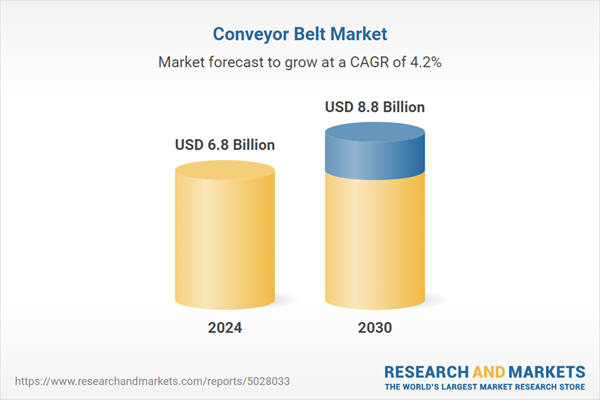Global Conveyor Belt Market - Key Trends and Drivers Summarized
How Are Conveyor Belts Powering Modern Industries?
Conveyor belts are a pivotal component in the mechanization of various production processes across numerous industries, including manufacturing, mining, agriculture, and transportation. Essentially, these belts are looped strips of durable materials like rubber, metal, or fabric designed to transport materials from one point to another continuously and efficiently. Their use significantly minimizes labor costs, enhances safety, and increases throughput in industrial operations. Conveyor systems can be customized with different belt materials and configurations to suit specific operational needs, such as heat resistance, oil resistance, or grip enhancement. This versatility makes conveyor belts indispensable in settings where quick and reliable handling of goods is required. For instance, in the food industry, conveyor belts not only transport ingredients through the production line but also ensure these processes meet health and safety standards by utilizing food-grade materials.What Innovations Are Shaping the Conveyor Belt Industry?
The conveyor belt industry is not static; it sees continual innovations that aim to improve efficiency and safety. Modern advancements include the integration of sensors and RFID tags that help monitor the condition and performance of conveyor belts in real time. These technologies enable predictive maintenance, where potential issues such as misalignments, tears, or blockages can be identified and rectified before they cause system failures, thus minimizing downtime and maintenance costs. Another significant innovation is the development of modular belts that are easier to install and maintain. These belts consist of individual interlocking pieces that can be replaced in sections as needed, which is more cost-effective and less labor-intensive than replacing entire belts. Moreover, the push towards sustainability has led to increased use of environmentally friendly materials in belt construction, such as recycled plastics or reduced volatile organic compound (VOC) materials.What Challenges Do Conveyor Belt Systems Face?
Despite their benefits, conveyor belt systems are not without challenges. The primary concern for many industries is the wear and tear that belts endure, which leads to operational disruptions and costly repairs or replacements. Environmental factors such as exposure to extreme temperatures, moisture, and corrosive materials can accelerate the degradation of belts. Additionally, the energy consumption of conveyor belt systems, especially in large-scale operations, can be significant, prompting a need for more energy-efficient designs. There is also the ongoing issue of ensuring that conveyor belts meet the stringent safety standards required in various industries to prevent accidents and injuries, necessitating regular inspections and adherence to safety protocols.What Drives the Growth in the Conveyor Belt Market?
The growth in the conveyor belt market is driven by several factors, including the expansion of industries such as mining, agriculture, and manufacturing globally. As these sectors expand, the demand for efficient material handling solutions like conveyor belts increases. Technological advancements that enhance the performance, safety, and environmental sustainability of conveyor belts also contribute to market growth. Economic growth in emerging markets is another driver, as new industrial and mining projects come online requiring extensive conveyor systems. Additionally, the trend towards automation and continuous production processes necessitates the adoption of sophisticated conveyor systems capable of handling high volumes of materials reliably. These factors, combined with the global push towards improving operational efficiencies and reducing labor costs, ensure that the demand for conveyor belt solutions remains robust in various industrial sectors.Report Scope
The report analyzes the Conveyor Belt market, presented in terms of market value (USD). The analysis covers the key segments and geographic regions outlined below.- Segments: Segment (Medium-Weight, Light-Weight, Heavy-Weight); Type (Flat Belt, Cleated Belt, Modular Belt); End-Use (Mining, Manufacturing, Chemicals, Oils & Gases, Aerospace, Other End-Uses).
- Geographic Regions/Countries: World; United States; Canada; Japan; China; Europe (France; Germany; Italy; United Kingdom; Spain; Russia; and Rest of Europe); Asia-Pacific (Australia; India; South Korea; and Rest of Asia-Pacific); Latin America (Argentina; Brazil; Mexico; and Rest of Latin America); Middle East (Iran; Israel; Saudi Arabia; United Arab Emirates; and Rest of Middle East); and Africa.
Key Insights:
- Market Growth: Understand the significant growth trajectory of the Flat Belt segment, which is expected to reach US$7 Billion by 2030 with a CAGR of 4.4%. The Cleated Belt segment is also set to grow at 3.6% CAGR over the analysis period.
- Regional Analysis: Gain insights into the U.S. market, valued at $1.8 Billion in 2024, and China, forecasted to grow at an impressive 6.4% CAGR to reach $1.9 Billion by 2030. Discover growth trends in other key regions, including Japan, Canada, Germany, and the Asia-Pacific.
Why You Should Buy This Report:
- Detailed Market Analysis: Access a thorough analysis of the Global Conveyor Belt Market, covering all major geographic regions and market segments.
- Competitive Insights: Get an overview of the competitive landscape, including the market presence of major players across different geographies.
- Future Trends and Drivers: Understand the key trends and drivers shaping the future of the Global Conveyor Belt Market.
- Actionable Insights: Benefit from actionable insights that can help you identify new revenue opportunities and make strategic business decisions.
Key Questions Answered:
- How is the Global Conveyor Belt Market expected to evolve by 2030?
- What are the main drivers and restraints affecting the market?
- Which market segments will grow the most over the forecast period?
- How will market shares for different regions and segments change by 2030?
- Who are the leading players in the market, and what are their prospects?
Report Features:
- Comprehensive Market Data: Independent analysis of annual sales and market forecasts in US$ Million from 2024 to 2030.
- In-Depth Regional Analysis: Detailed insights into key markets, including the U.S., China, Japan, Canada, Europe, Asia-Pacific, Latin America, Middle East, and Africa.
- Company Profiles: Coverage of players such as Bando Chemical Industries Ltd., Bridgestone Corporation, Chiorino SpA, ContiTech AG, Fenner Drives Inc. and more.
- Complimentary Updates: Receive free report updates for one year to keep you informed of the latest market developments.
Some of the 41 companies featured in this Conveyor Belt market report include:
- Bando Chemical Industries Ltd.
- Bridgestone Corporation
- Chiorino SpA
- ContiTech AG
- Fenner Drives Inc.
- Habasit AG
- Intralox LLC
- Omtech Food Engineering
- The Yokohama Rubber Co., Ltd.
- Volta Belting Technology Ltd.
- YongLi Belting
This edition integrates the latest global trade and economic shifts into comprehensive market analysis. Key updates include:
- Tariff and Trade Impact: Insights into global tariff negotiations across 180+ countries, with analysis of supply chain turbulence, sourcing disruptions, and geographic realignment. Special focus on 2025 as a pivotal year for trade tensions, including updated perspectives on the Trump-era tariffs.
- Adjusted Forecasts and Analytics: Revised global and regional market forecasts through 2030, incorporating tariff effects, economic uncertainty, and structural changes in globalization. Includes historical analysis from 2015 to 2023.
- Strategic Market Dynamics: Evaluation of revised market prospects, regional outlooks, and key economic indicators such as population and urbanization trends.
- Innovation & Technology Trends: Latest developments in product and process innovation, emerging technologies, and key industry drivers shaping the competitive landscape.
- Competitive Intelligence: Updated global market share estimates for 2025, competitive positioning of major players (Strong/Active/Niche/Trivial), and refined focus on leading global brands and core players.
- Expert Insight & Commentary: Strategic analysis from economists, trade experts, and domain specialists to contextualize market shifts and identify emerging opportunities.
Table of Contents
Companies Mentioned (Partial List)
A selection of companies mentioned in this report includes, but is not limited to:
- Bando Chemical Industries Ltd.
- Bridgestone Corporation
- Chiorino SpA
- ContiTech AG
- Fenner Drives Inc.
- Habasit AG
- Intralox LLC
- Omtech Food Engineering
- The Yokohama Rubber Co., Ltd.
- Volta Belting Technology Ltd.
- YongLi Belting
Table Information
| Report Attribute | Details |
|---|---|
| No. of Pages | 380 |
| Published | December 2025 |
| Forecast Period | 2024 - 2030 |
| Estimated Market Value ( USD | $ 6.8 Billion |
| Forecasted Market Value ( USD | $ 8.8 Billion |
| Compound Annual Growth Rate | 4.2% |
| Regions Covered | Global |









